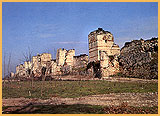|
The
topography of the Queen City
 In
324,
Constantine I
(307-337) chose to fix his residence at Byzantium, an ancient
Megarian colony, between the Black Sea and the Sea of Marmara
(Propontis). The town was a naturaly fortified site surrounded
by sea and provided with two harbours on the side of the Golden
Horn. Constantine constructed a wall to its west, enlarged
the already existing streets and hippodrome, multiplied the
public places, which he adorned with statues and arches, and
added a vast imperial palace and a few churches, such as the
church of St Irene and that of the Holy Apostles. In
324,
Constantine I
(307-337) chose to fix his residence at Byzantium, an ancient
Megarian colony, between the Black Sea and the Sea of Marmara
(Propontis). The town was a naturaly fortified site surrounded
by sea and provided with two harbours on the side of the Golden
Horn. Constantine constructed a wall to its west, enlarged
the already existing streets and hippodrome, multiplied the
public places, which he adorned with statues and arches, and
added a vast imperial palace and a few churches, such as the
church of St Irene and that of the Holy Apostles.
Constantinople's remarkable expansion in the decades
following its inauguration (330) is witnessed by the increasing
number of fora (open air plazas), monuments and mansions,
its new harbour, and the double land walls (413) built under
Theodosios II
(408-450).
Fifth century sources mention no less than 52 colonnades,
4
fora,
2 theatres in addition to the hippodrome, 322 streets, 5 imperial
and 9 princely  palaces,
4388 mansions, 8 public and 153 baths, 14 churches and 5 granaries,
all within the inner Constantinian wall. The Mese was the
city's main commercial street and a major artery for imperial
processions and
triumphs. It ran from the Milion, the first
milestone of the empire, near St Sophia and the Hippodrome,
to the Forum of Constantine, the Forum of Theodosios (Tauri),
the Forum Amastrianum, the Forum Bovis and the Forum of
Arkadios. Beyond
that point, the Mese ran parallel to the shore until it reached
the Golden Gate, the main gate of the Theodosian wall, used
in imperial processions. Shortly after the Forum of Theodosios,
at a cross-road known as the Philadelphion , the Mese forked,
one arm extending in a northwesterly direction toward the
Church of the Holy Apostles, the imperial mausoleum. palaces,
4388 mansions, 8 public and 153 baths, 14 churches and 5 granaries,
all within the inner Constantinian wall. The Mese was the
city's main commercial street and a major artery for imperial
processions and
triumphs. It ran from the Milion, the first
milestone of the empire, near St Sophia and the Hippodrome,
to the Forum of Constantine, the Forum of Theodosios (Tauri),
the Forum Amastrianum, the Forum Bovis and the Forum of
Arkadios. Beyond
that point, the Mese ran parallel to the shore until it reached
the Golden Gate, the main gate of the Theodosian wall, used
in imperial processions. Shortly after the Forum of Theodosios,
at a cross-road known as the Philadelphion , the Mese forked,
one arm extending in a northwesterly direction toward the
Church of the Holy Apostles, the imperial mausoleum.
From the Propontis to the Golden Horn, the city was
protected by massive land fortifications, comprising an inner
wall with towers, a lower outer wall, also with towers, and
a moat. The sea front was protected by a single row of fortifications.
Both the land and sea walls were built of bonded masonry,
with alternating bands of brick and cut-stone facing, the
latter enclosing a core of mortared rubble.
The city soon competed in size, importance and splendor
with the old metropolis' of Rome, Alexandria and Antioch.
Like all great capitals, Constantinople was a melting-pot
of peoples and languages, attracting provincials and barbarians
alike, the former settling there or drifting in and out on
business of all kinds, the latter as part of the servile class
or of mercenary military units. By the sixth century, the
city's population had grown to around 300000-400000.
|